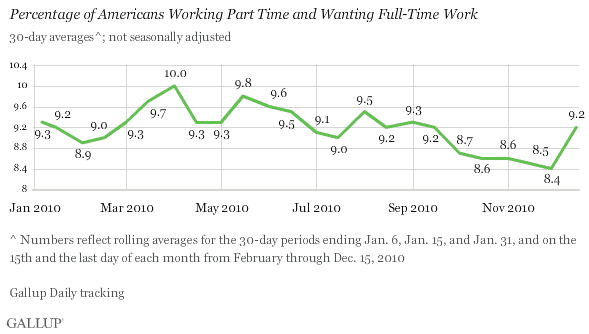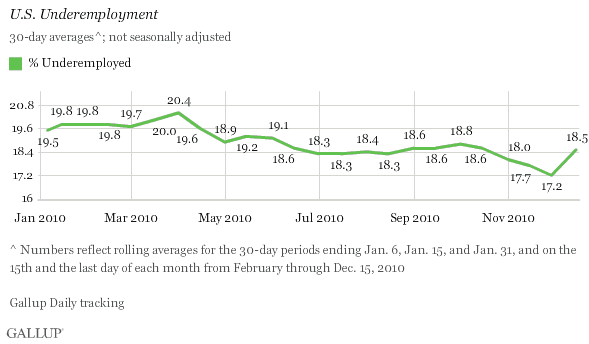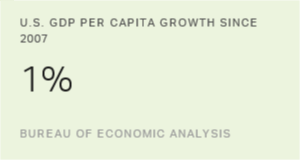PRINCETON, NJ -- Unemployment, as measured by Gallup without seasonal adjustment, increased to 9.3% in mid-December -- up from 8.8% at the end of November and roughly matching the 9.2% of mid-November.

The percentage of part-time workers who want full-time work increased to 9.2% of the workforce in mid-December -- up from 8.4% at the end of November, and the highest since mid-September. This suggests that the situation facing those working part time but looking for full-time work has deteriorated sharply during recent weeks.

Underemployment Up Sharply in Mid-December
The increase in Gallup's U.S. unemployment rate and the substantial worsening in the percentage of part-time workers wanting full-time work combined to send underemployment surging to 18.5% in mid-December from 17.2% at the end of November. Underemployment now matches the levels seen in September and mid-October.

Unemployment Situation Worsens as Seasonal Jobs Disappear
Because the Gallup unemployment measure is not seasonally adjusted, it reflects what is actually taking place in the U.S. job market. Combined with Gallup Daily tracking of employment, it seems likely that the recent surge in underemployment and unemployment reflects the end of the Christmas hiring season.
Gallup's U.S. unemployment measure remains well below the government's unemployment rate of 9.8% for November. But the encouraging job trends of late October and November do not seem to be continuing into early December. Further, the end of Christmas hiring and the normally slow winter job market will continue to adversely affect jobs in early 2011. It is not clear whether this recent worsening of the employment situation will negatively affect last-minute Christmas spending and the optimism around it -- but it is possible.
Gallup.com reports results from these indexes in daily, weekly, and monthly averages and in Gallup.com stories. Complete trend data are always available to view and export in the following charts:
Daily: Employment, Economic Confidence and Job Creation, Consumer Spending
Weekly: Employment, Economic Confidence, Job Creation, Consumer Spending
Read more about Gallup's economic measures.
View our economic release schedule.
Survey Methods
Gallup classifies American workers as underemployed if they are either unemployed or working part time but wanting full-time work. The findings reflect more than 18,000 phone interviews with U.S. adults aged 18 and older in the workforce, collected over a 30-day period. Gallup's results are not seasonally adjusted and tend to be a precursor of government reports by approximately two weeks.
Results are based on telephone interviews conducted as part of Gallup Daily tracking Nov. 16-Dec. 15, 2010, with a random sample of 18,082 adults, aged 18 and older, living in all 50 U.S. states and the District of Columbia, selected using random-digit-dial sampling.
Interviews are conducted with respondents on landline telephones and cellular phones, with interviews conducted in Spanish for respondents who are primarily Spanish-speaking. Each daily sample includes a minimum quota of 150 cell phone respondents and 850 landline respondents, with additional minimum quotas among landline respondents for gender within region. Landline respondents are chosen at random within each household on the basis of which member had the most recent birthday.
Samples are weighted by gender, age, race, Hispanic ethnicity, education, region, adults in the household, cell phone-only status, cell phone-mostly status, and phone lines. Demographic weighting targets are based on the March 2009 Current Population Survey figures for the aged 18 and older non-institutionalized population living in U.S. telephone households. All reported margins of sampling error include the computed design effects for weighting and sample design.
In addition to sampling error, question wording and practical difficulties in conducting surveys can introduce error or bias into the findings of public opinion polls.
For more details on Gallup's polling methodology, visit www.gallup.com.
